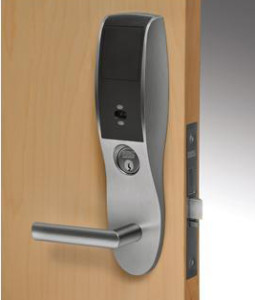 Electromechanical locks have come a long way in the past ten years, their biggest developments being in the wireless locks category. Wireless locks are a hot commodity these days because they cut down on one of the major hassles of installing an access control system – wiring.
Electromechanical locks have come a long way in the past ten years, their biggest developments being in the wireless locks category. Wireless locks are a hot commodity these days because they cut down on one of the major hassles of installing an access control system – wiring.
Wireless Locks on Exterior Doors: Why?
Since modern day access control systems are a relatively new development, the majority of the time they’re being installed into pre-existing buildings. This presents a unique set of challenges when it comes to running the wiring from the locks to the control room, which, more often than not, isn’t even located on the same floor.
In fact, we’re lucky if the control room is in the same building. Because of this, technicians have to run wires through walls, ceilings, and sometimes even underground. All that difficult wiring means costs add up quickly.
Upfront, most wireless locks cost almost twice that of a hardwired lock, but don’t forget the savings you will gain on the back end, bypassing all that pesky – and pricey – wiring.
Wireless locks also have the card reader built into the lock, negating the need to have a card reader affixed to the building. The result? A cleaner, less cluttered look to the opening.
Do Wireless Locks Have Any Drawbacks?
Yes. Just like with any product, there are always a few drawbacks. It’s up to you to weigh them out and determine which product will work best for your particular facility. Here are a few issues you might want to consider.
Inability to Lock Down
Depending on how you have your lock set to check in, there can be gaps in time when the lock is not communicating with the host. Because of this, it’s not always possible to immediately go into lockdown. For example, if you have your lock set to check in every 90 seconds, and it checks in, if you need to go into lockdown 30 seconds after the last check in, you would still have to wait a full minute before you could go into lockdown. You can set your lock to check in every 5 seconds if you want, but that combined with the amount of card reads you have per day is going to drain your battery life very quickly.
Battery Life
Wireless locks draw their power from batteries and not from a power grid. They are also locks that “talk” to their host at certain intervals determined by you. The more the lock “talks” to the host, the more battery power it uses. Depending on how often you have your lock set to check in will determine how often you have to go and change those batteries. Wireless locks also use battery power when they read cards, so the number of card reads you have per day will also impact how long your batteries last.
Installation
When it comes to wireless locks you have the option of two different types. The first allows the lock to talk to hubs hardwired back to the host. The other is capable of talking directly to the host with the use of a wireless signal.
The type of wireless locks that talk to various hubs requires the hubs to also be installed, and installed within a certain proximity of the lock. This can be challenging depending on the layout of the building.
The wireless locks that speak directly to the host, while not requiring various hubs within a certain range, are however susceptible to both wireless chatter and security breaches.
What We Recommend
Truthfully, we don’t recommend wireless locks for exterior doors. Instead, we recommend you install hardwired locks on exterior doors and leave the wireless locks to interior doors. There are a number of different product lines that will aesthetically blend together, making everything look uniform.
If you have any questions or need assistance selecting the best product for you, let us know. We’re happy to help!
